An Integrated Software Framework to Support Semantic Modeling and Reasoning of Spatiotemporal Change of Geographical Objects: A Use Case of Land Use and Land Cover Change Study
Abstract
:1. Introduction
2. Literature Review
2.1. Progress in Enhancing the Semantic Interoperability of Existing LULC Classification Systems
2.2. Progress in Developing a Spatiotemporal Reasoning Platform
3. Building Blocks of the Semantic Platform
3.1. Geospatial Ontology for LULCC
3.2. Defining Reasoning Rules
3.3. An Integrated Software Framework to Support Semantic Query and Reasoning
4. Demonstrations and Discussions
4.1. Data and Study Area
4.2. Ontological Implementation for the LULCC Data
4.3. Change Information Query Based on Semantic Reasoning
5. Experiments
6. Conclusions
Acknowledgments
Author Contributions
Conflicts of Interest
References
- Bambacus, M.; Yang, C.; Evans, J.; Li, Z.; Li, W.; Huang, Q. Sharing earth science information to support the Global Earth Observing System of Systems (GEOSS). In Proceedings of the IGARSS 2008—2008 IEEE International Geoscience and Remote Sensing Symposium, Boston, MA, USA, 6–11 July 2008.
- Yang, C.; Li, W.; Xie, J.; Zhou, B. Distributed geospatial information processing: Sharing distributed geospatial resources to support Digital Earth. Int. J. Digit. Earth 2008, 1, 259–278. [Google Scholar] [CrossRef]
- Liu, B.; Wang, M.; Hong, R.C.; Zha, Z.J.; Hua, X.S. Joint learning of labels and distance metric. IEEE Trans. Syst. Man Cybern Part B 2010, 40, 973–978. [Google Scholar] [CrossRef] [PubMed]
- Li, W.; Yang, C.W.; Nebert, D.; Raskin, R.; Houser, P.; Wu, H.; Li, Z. Semantic-based web service discovery and chaining for building an Arctic spatial data infrastructure. Comput. Geosci. 2011, 37, 1752–1762. [Google Scholar] [CrossRef]
- Albalawi, E.K.; Kumar, L. Using remote sensing technology to detect, model and map desertification: A review. J. Food Agric. Environ. 2013, 11, 791–797. [Google Scholar]
- Klein, I.; Dietz, A.J.; Gessner, U.; Galayeva, A.; Myrzakhmetov, A.; Kuenzer, C. Evaluation of seasonal water body extents in Central Asia over the past 27 years derived from medium-resolution remote sensing data. Int. J. Geogr. Inf. 2014, 26, 335–349. [Google Scholar] [CrossRef]
- Kennedy, R.E.; Townsend, P.A.; Gross, J.E.; Cohen, W.B.; Bolstad, P.; Wang, Y.Q.; Adams, P. Remote sensing change detection tools for natural resource managers: Understanding concepts and tradeoffs in the design of landscape monitoring projects. Remote Sens. Environ. 2009, 113, 1382–1396. [Google Scholar] [CrossRef]
- Hamandawana, H.; Eckardt, F.; Chanda, R. Linking archival and remotely sensed data for long-term environmental monitoring. Int. J. Appl. Earth Obs. Geoinform. 2005, 7, 284–298. [Google Scholar] [CrossRef]
- Matchanov, M.; Teodoro, A.; Schroder, C. Criterion definition for the identification of physical-geographical boundaries of Khorezm oasis through remotely sensed data. Environ. Monit. Assess. 2016, 188, 1–14. [Google Scholar] [CrossRef] [PubMed]
- Arenas, H.; Harbelot, B.; Cruz, C. LC3: A spatiotemporal data model to study qualified land cover changes. In Land Use and Land Cover Semantics: Principles, Best Practices, and Prospects; Ahlqvist, O., Varanka, D., Fritz, S., Janowicz, K., Eds.; CRC Press: Boca Raton, FL, USA, 2015; pp. 211–242. [Google Scholar]
- Shi, X. Where are the spatial relationships in the spatial ontologies? Proc. Natl. Acad. Sci. USA 2011, 108, E459. [Google Scholar] [CrossRef] [PubMed]
- Gribb, W.J.; Czerniak, R.J. Land use/land cover classification systems and their relationship to land planning. In Land Use and Land Cover Semantics: Principles, Best Practices, and Prospects; CRC Press: Boca Raton, FL, USA, 2015; pp. 1–18. [Google Scholar]
- Lu, D.; Mausel, P.; Brondizio, E.; Moran, E. Change detection techniques. Int. J. Remote Sens. 2004, 25, 2365–2407. [Google Scholar] [CrossRef]
- Ahlqvist, O. Extending post-classification change detection using semantic similarity metrics to overcome class heterogeneity: A study of 1992 and 2001 US National Land Cover Database changes. Remote Sens. Environ. 2008, 112, 1226–1241. [Google Scholar] [CrossRef]
- Liu, Z.G.; Dezert, J.; Mercier, G.; Pan, Q. Dynamic evidential reasoning for change detection in remote sensing images. IEEE Trans. Geosci. Remote 2012, 50, 1955–1967. [Google Scholar] [CrossRef]
- Björk, A.; Skånes, H. The need for awareness of semantic plasticity in international harmonization of geographical information: seen from a nordic forest classification perspective. In Land Use and Land Cover Semantics: Principles, Best Practices and Prospects; CRC Press: Boca Raton, FL, USA, 2015; pp. 41–58. [Google Scholar]
- Anderson, J.R. A Land Use and Land Cover Classification System for Use with Remote Sensor Data; US Government Printing Office: Washington, DC, USA, 1976.
- European Environment Agency (EEA). CORINE Land Cover Technical Guide: Addendum 2000. Available online: http://www.eea.europa.eu/publications/tech40add (accessed on 10 February 2016).
- American Planning Association. Land-Based Classification Standards. 2001. Available online: https://www.planning.org/lbcs/standards/pdf/InOneFile.pdf (accessed on 10 February 2016).
- Di Gregorio, A. Land Cover Classification System: Classification Concepts and User Manual. Available online: http://www.fao.org/docrep/008/y7220e/y7220e00.HTM (accessed on 10 February 2016).
- Harrison, A.R. National Land Use Database: Land Use and Land Cover Classification; O. Office of the Deputy Prime Minister, Ed.; Queen’s Printer and Controller of Her Majesty’s Stationery Office: London, UK, 2006.
- Jansen, L.J. Parameterized approaches to the categorization of land use and land cover. In Land Use and Land Cover Semantics: Principles, Best Practices, and Prospects; CRC Press: Boca Raton, FL, USA, 2015; pp. 59–84. [Google Scholar]
- Annoni, A. INSPIRE: Infrastructure of spatial information in Europe. In Proceedings of the 9th EC GIS&GI A, Coruna, Espana, 25–27 June 2003.
- Rips, L.J.; Shoben, E.J.; Smith, E.E. Semantic distance and the verification of semantic relations. J. Verbal Learn. Verbal Behav. 1973, 12, 1–20. [Google Scholar] [CrossRef]
- Tversky, A. Features of similarity. Psychol. Rev. 1977, 84, 327–352. [Google Scholar] [CrossRef]
- Li, W.; Raskin, R.; Goodchild, M.F. Semantic similarity measurement based on knowledge mining: An artificial neural net approach. Int. J. Geogr. Inf. Sci. 2012, 26, 1415–1435. [Google Scholar] [CrossRef]
- Sunna, W.; Cruz, I.F. Structure-based methods to enhance geospatial ontology alignment. In GeoSpatial Semantics; Springer: Berlin/Heidelberg, Germany, 2007; pp. 82–97. [Google Scholar]
- Goldstone, R.L. Similarity, interactive activation, and mapping. J. Exp. Psychol. Learn. Mem. Cogn. 1994, 20, 3–28. [Google Scholar] [CrossRef]
- Lin, D. An information-theoretic definition of similarity. ICML 1998, 98, 296–304. [Google Scholar]
- Comber, A.; Fisher, P.; Wadsworth, R. Text mining analysis of land cover semantic overlap. In Land Use and Land Cover Semantics: Principles, Best Practices, and Prospects; CRC Press: Boca Raton, FL, USA, 2015; pp. 197–204. [Google Scholar]
- Hornsby, K.; Egenhofer, M.J. Identity-based change: A foundation for spatio-temporal knowledge representation. Int. J. Geogr. Inf. Sci. 2000, 14, 207–224. [Google Scholar] [CrossRef]
- Worboys, M.F. Modelling changes and events in dynamic spatial systems with reference to socio-economic units. In Proceedings of the ESF GISDATA Conference on Modelling Change in Socio-Economic Units, Napthlion, Greece, 15–19 March 1998.
- Claramunt, C.; Jiang, B. An integrated representation of spatial and temporal relationships between evolving regions. J. Geogr. Syst. 2001, 3, 411–428. [Google Scholar] [CrossRef]
- Jiang, J.; Worboys, M. Event-based topology for dynamic planar areal objects. Int. J. Geogr. Inf. Sci. 2009, 23, 33–60. [Google Scholar] [CrossRef]
- Varanka, D.E.; Usery, E.L. An applied ontology for semantics associated with surface water features. In Land Use and Land Cover Semantics: Principles, Best Practices, and Prospects; CRC Press: Boca Raton, FL, USA, 2015; pp. 146–168. [Google Scholar]
- Prasad, A.R.D.; Guha, N. Concept naming vs. concept categorisation: A faceted approach to semantic annotation. Online Inf. Rev. 2008, 32, 500–510. [Google Scholar] [CrossRef]
- Batsakis, S.; Petrakis, E.G. Representing temporal knowledge in the semantic web: The extended 4d fluents approach. In Combinations of Intelligent Methods and Applications; Springer: Berlin/Heidelberg, Germany, 2011; pp. 55–69. [Google Scholar]
- Klyne, G.; Carroll, J.J. Resource Description Framework (RDF): Concepts and Abstract Syntax; W3C: Cambridge, MA, USA, 2006. [Google Scholar]
- McGuinness, D.L.; Van Harmelen, F. OWL web ontology language overview. W3C Recomm. 2004, 10, 1–22. [Google Scholar]
- Gutierrez, C.; Hurtado, C.; Vaisman, A. Introducing time into RDF. EEE Trans. Knowl. Data Eng. 2007, 19, 207–218. [Google Scholar] [CrossRef]
- Frasincar, F.; Milea, V.; Kaymak, U. tOWL: Integrating time in OWL; Springer: Berlin/Heidelberg, Germany, 2010. [Google Scholar]
- Krieger, H.U. A General Methodology for Equipping Ontologies with Time. Available online: http://citeseerx.ist.psu.edu/viewdoc/download?doi=10.1.1.168.1549&rep=rep1&type=pdf (accessed on 23 June 2016).
- Bereta, K.; Smeros, P.; Koubarakis, M. Representing and querying the valid time of triples for Linked Geospatial data. In Proceedings of the 10th Extended Semantic Web Conference (ESWC 13), Monpellier, France, 26–30 May 2013.
- Huang, Y.; Deng, G. Research on representation of geographic spatio-temporal information and spatio-temporal reasoning rules based on geo-ontology and SWRL. In Proceedings of the International Conference on Environmental Science and Information Application Technology, Wuhan, China, 4–5 July 2009.
- Sotirios, B. SOWL: A Framework for Handling Spatio-Temporal Information in OWL. Ph.D. Thesis, Technical University of Crete, Chania, Greece, 2011. [Google Scholar]
- Bledsoe, B.P.; Brown, M.C.; Raff, D.A. GeoTools: A toolkit for fluvial system analysis. J. Am. Water Resour. Assoc. 2007, 43, 757–772. [Google Scholar] [CrossRef]
- McBride, B. Jena: A semantic web toolkit. IEEE Int. Comput. 2002, 6, 55–59. [Google Scholar] [CrossRef]
- Prud’Hommeaux, E.; Seaborne, A. SPARQL Query Language for RDF. Available online: http://www.w3.org/TR/rdf-sparql-query/ (accessed on 23 June 2016).
- PolarGlobe. Available online: http://polar.geodacenter.org/lulcc (accessed on 26 September 2016).
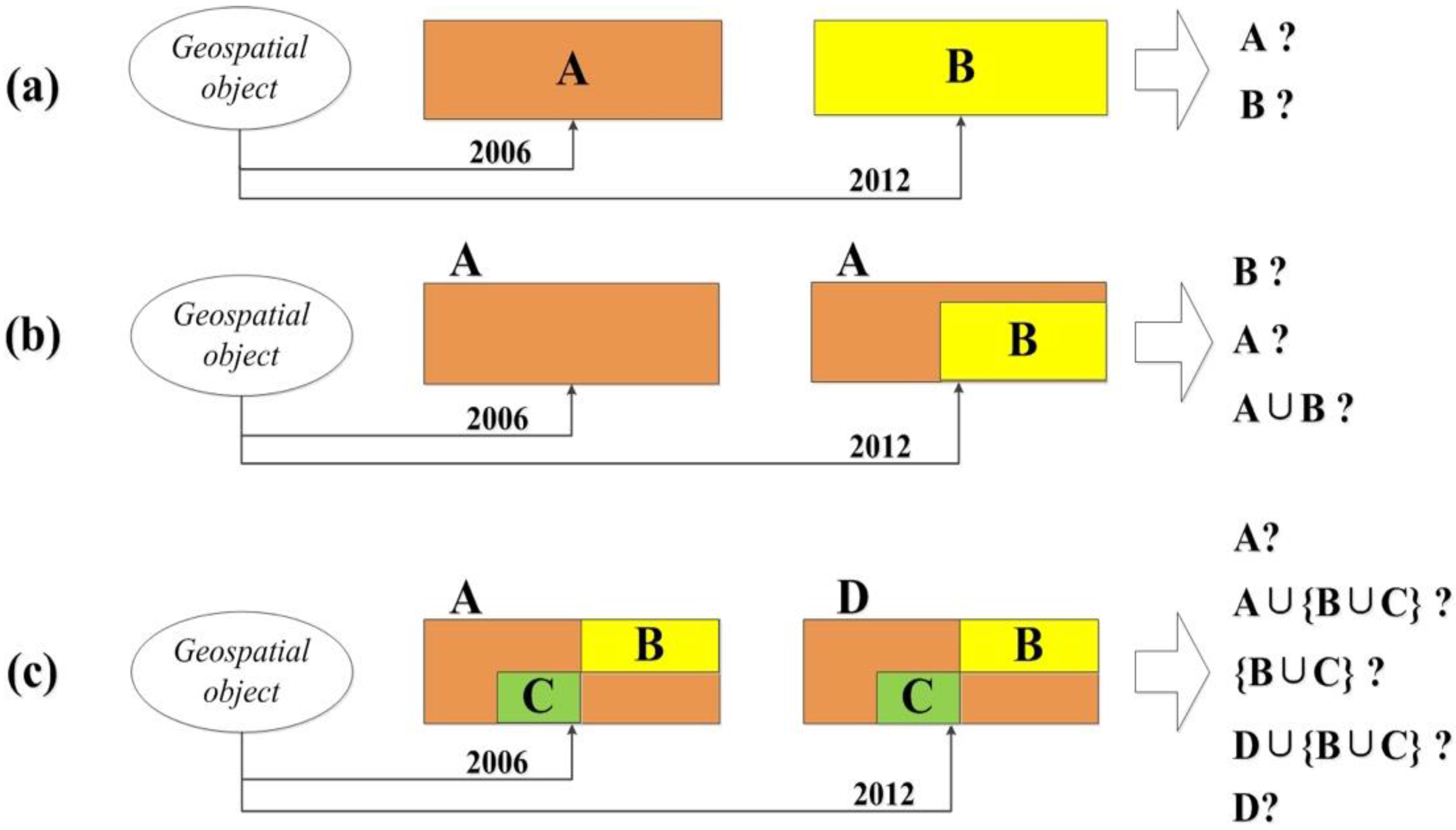
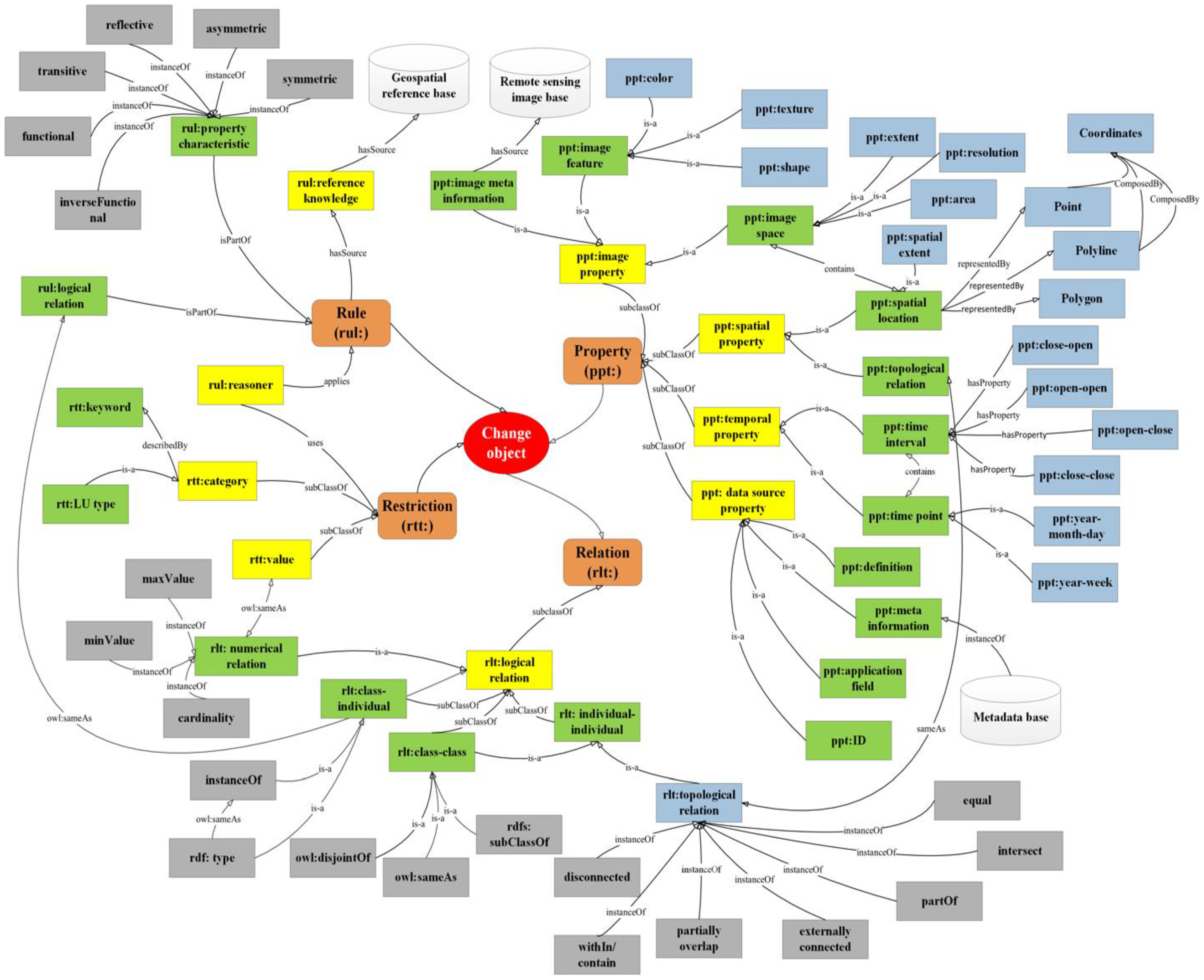
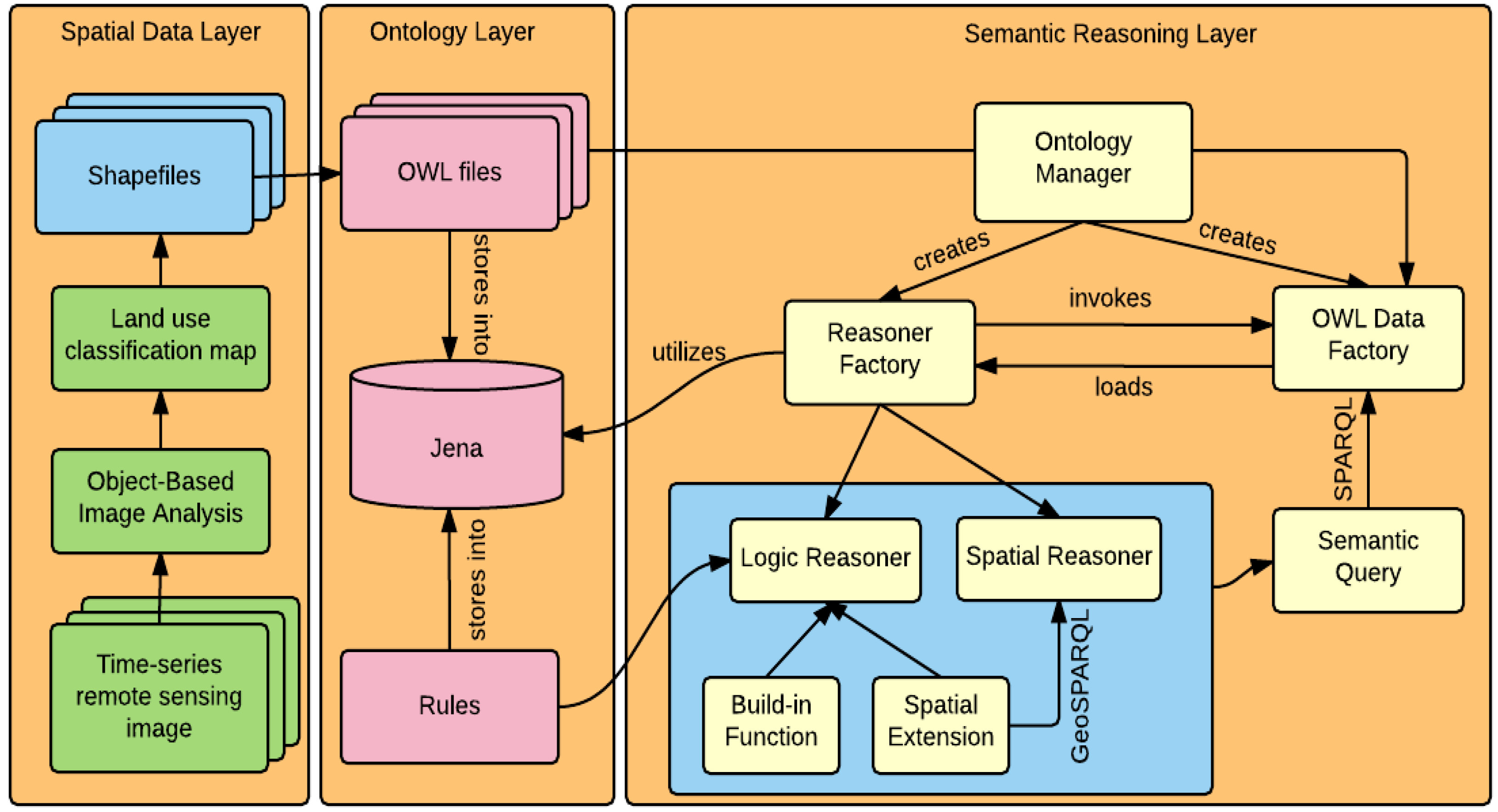
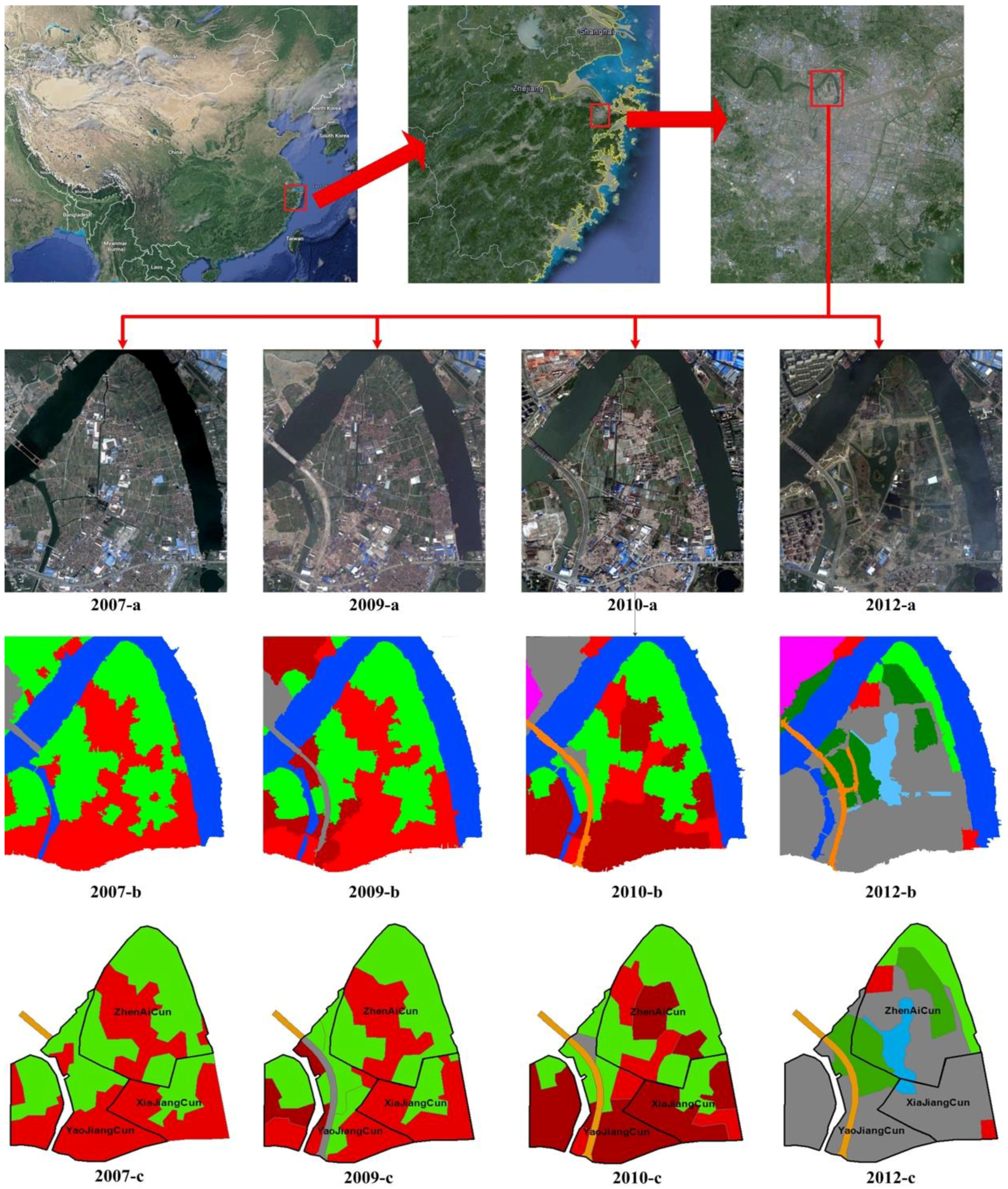



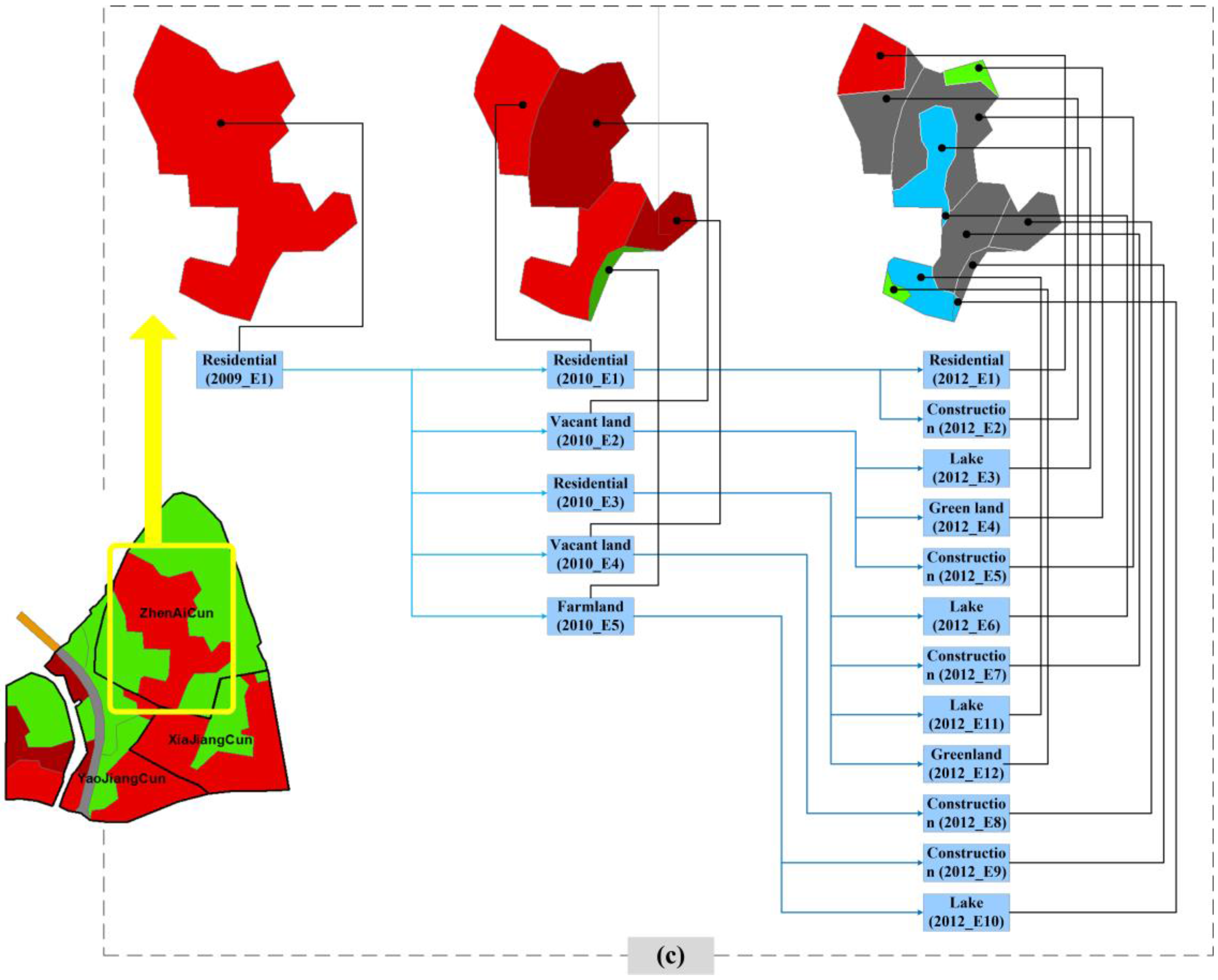
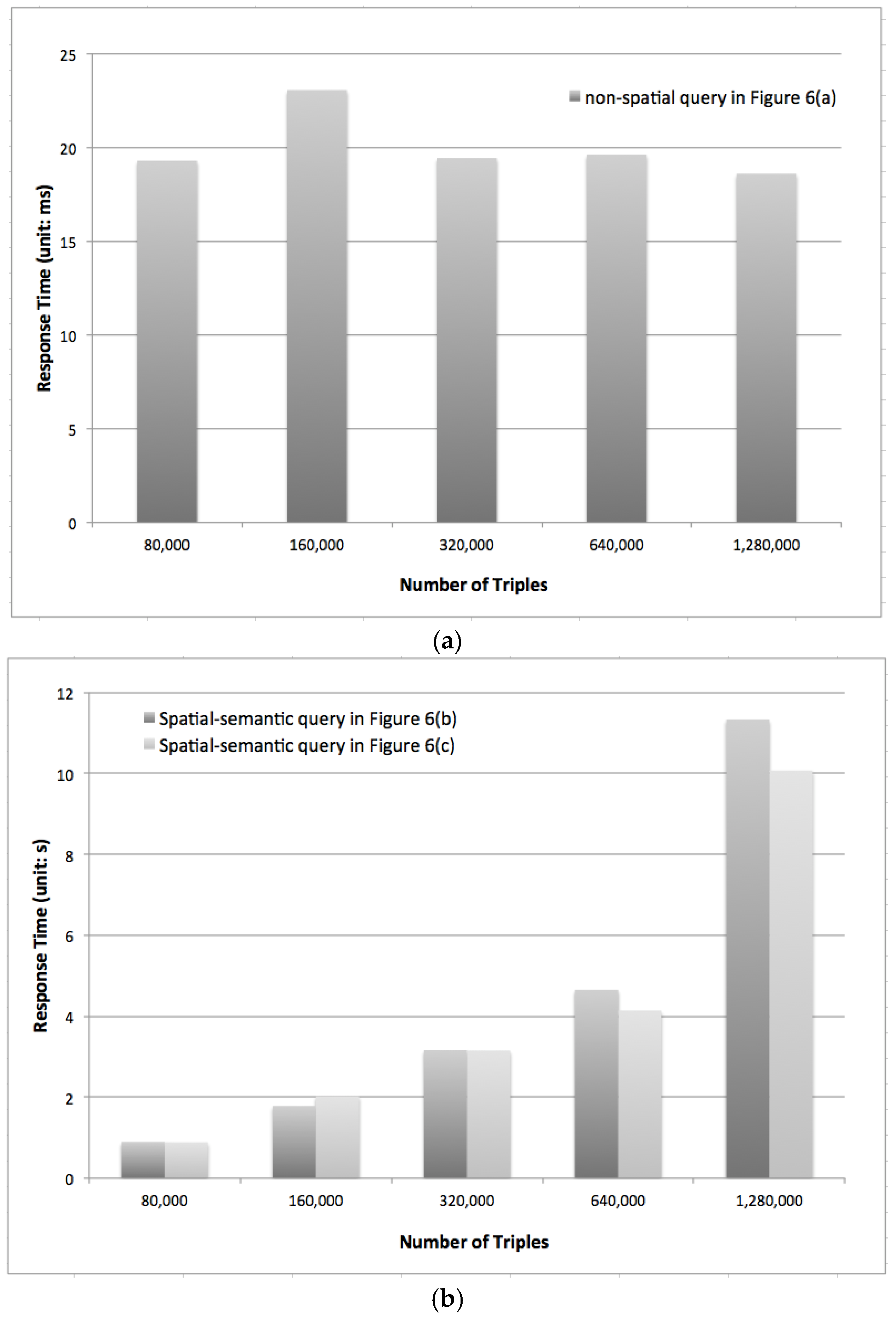
| Satellite Image | QuickBird |
|---|---|
| Date | 22 August 2007 5 June 2009 12 March 2010 16 April 2012 |
| Waveband | Blue: 450–520 nm Green: 520–600 nm Red: 630–690 nm |
| Spatial resolution | 0.65 m |
| Village | Land Cover (2007) | Land Cover (2009) | Land Cover (2010) | Land Cover (2012) |
|---|---|---|---|---|
| ZhenAiCun | Residential (34.5%) Agriculture (65.5%) | Residential (34.5%) Agriculture (65.5%) | Residential (64.0%) Agriculture (16.7%) Urban vacant (19.3%) | Residential (4.6%) Agriculture (20.8%) Under construction (37.6%) Park (25.2%) Waters (11.8%) |
| XiaJiangCun | Residential (47.95%) Agriculture (31.22%) Industrial (20.83%) | Residential (47.95%) Agriculture (31.22%) Industrial (20.83%) | Residential (30.1%) Agriculture (26.5%) Urban vacant (11.3%) Industrial (32.2%) | Industrial (4.1%) Under construction (92.1%) Waters (3.7%) |
| YaoJiangCun | Residential (36.9%) Agriculture (44.6%) Industrial (18.5%) | Residential (29.2%) Agriculture (35.4%) Under construction (20.8%) Industrial (14.6%) | Residential (9.1%) Agriculture (22.5%) Urban vacant (44.8%) Under construction (3.1%) Transportation (7.8%) Industrial (12.7%) | Residential (22.8%) Industrial (3.0%) Under construction (49.2%) Park (17.3%) Transportation (7.8%) |
| Wantou Bridge | Under construction (100%) | Transportation (100%) | Transportation (100%) | Transportation (100%) |
© 2016 by the authors; licensee MDPI, Basel, Switzerland. This article is an open access article distributed under the terms and conditions of the Creative Commons Attribution (CC-BY) license (http://creativecommons.org/licenses/by/4.0/).
Share and Cite
Li, W.; Zhou, X.; Wu, S. An Integrated Software Framework to Support Semantic Modeling and Reasoning of Spatiotemporal Change of Geographical Objects: A Use Case of Land Use and Land Cover Change Study. ISPRS Int. J. Geo-Inf. 2016, 5, 179. https://doi.org/10.3390/ijgi5100179
Li W, Zhou X, Wu S. An Integrated Software Framework to Support Semantic Modeling and Reasoning of Spatiotemporal Change of Geographical Objects: A Use Case of Land Use and Land Cover Change Study. ISPRS International Journal of Geo-Information. 2016; 5(10):179. https://doi.org/10.3390/ijgi5100179
Chicago/Turabian StyleLi, Wenwen, Xiran Zhou, and Sheng Wu. 2016. "An Integrated Software Framework to Support Semantic Modeling and Reasoning of Spatiotemporal Change of Geographical Objects: A Use Case of Land Use and Land Cover Change Study" ISPRS International Journal of Geo-Information 5, no. 10: 179. https://doi.org/10.3390/ijgi5100179






